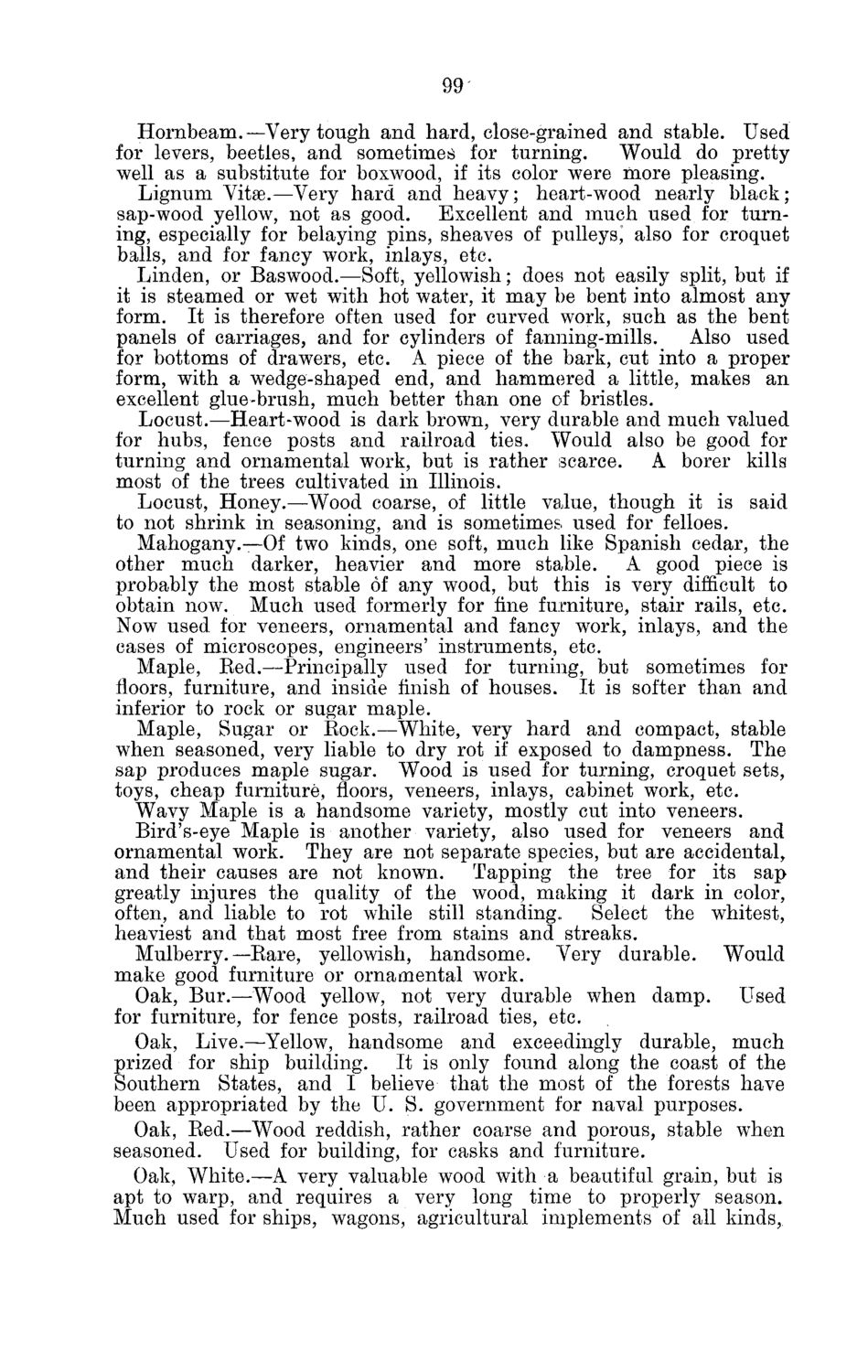| |
| |
Caption: Board of Trustees Minutes - 1880
This is a reduced-resolution page image for fast online browsing.

EXTRACTED TEXT FROM PAGE:
99' Hornbeam.—Very tough and hard, close-grained and stable. Used for levers, beetles, and sometimes for turning. Would do pretty well as a substitute for boxwood, if its color were more pleasing. Lignum Vitse.—Very hard and heavy; heart-wood nearly black; sap-wood yellow, not as good. Excellent and much used for turning, especially for belaying pins, sheaves of pulleys, also for croquet balls, and for fancy work, inlays, etc. Linden, or Baswood.—Soft, yellowish; does not easily split, but if it is steamed or wet with hot water, it may be bent into almost any form. It is therefore often used for curved work, such as the bent panels of carriages, and for cylinders of fanning-mills. Also used for bottoms of drawers, etc. A piece of the bark, cut into a proper form, with a wedge-shaped end, and hammered a little, makes an excellent glue-brush, much better than one of bristles. Locust.—Heart-wood is dark brown, very durable and much valued for hubs, fence posts and railroad ties. Would also be good for turning and ornamental work, but is rather scarce. A borer kills most of the trees cultivated in Illinois. Locust, Honey.—Wood coarse, of little value, though it is said to not shrink in seasoning, and is sometimes used for felloes. Mahogany.—Of two kinds, one soft, much like Spanish cedar, the other much darker, heavier and more stable. A good piece is probably the most stable of any wood, but this is very difficult to obtain now. Much used formerly for fine furniture, stair rails, etc. Now used for veneers, ornamental and fancy work, inlays, and the cases of microscopes, engineers' instruments, etc. Maple, Ked.—Principally used for turning, but sometimes for floors, furniture, and inside finish of houses. It is softer than and inferior to rock or sugar maple. Maple, Sugar or Bock.—White, very hard and compact, stable when seasoned, very liable to dry rot if exposed to dampness. The sap produces maple sugar. Wood is used for turning, croquet sets, toys, cheap furniture, floors, veneers, inlays, cabinet work, etc. Wavy Maple is a handsome variety, mostly cut into veneers. Bird's-eye Maple is another variety, also used for veneers and ornamental work. They are not separate species, but are accidental, and their causes are not known. Tapping the tree for its sap greatly injures the quality of the wood, making it dark in color, often, and liable to rot while still standing., Select the whitest, heaviest and that most free from stains and streaks. Mulberry.—Bare, yellowish, handsome. Very durable. Would make good furniture or ornamental work. Oak, Bur.—Wood yellow, not very durable when damp. Used for furniture, for fence posts, railroad ties, etc. Oak, Live.—Yellow, handsome and exceedingly durable, much prized for ship building. It is only found along the coast of the Southern States, and I believe that the most of the forests have been appropriated by the U. S. government for naval purposes. Oak, Bed.—Wood reddish, rather coarse and porous, stable when seasoned. Used for building, for casks and furniture. Oak, White.—A very valuable wood with a beautiful grain, but is apt to warp, and requires a very long time to properly season. Much used for ships, wagons, agricultural implements of all kinds,
| |